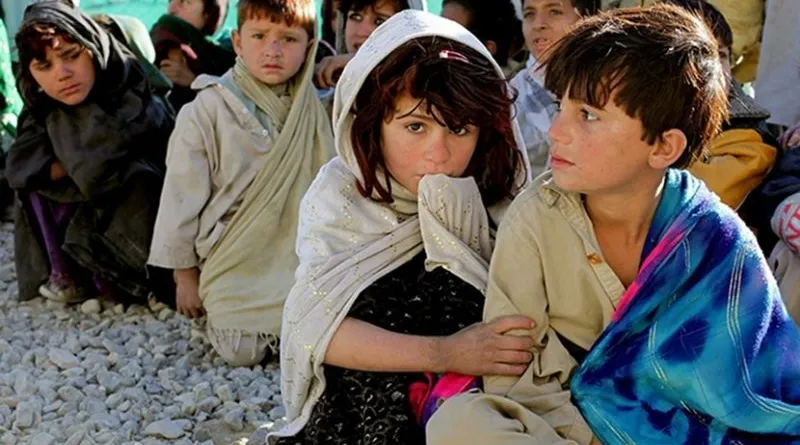
Afghanistan remains in the grip of multiple crises, with its humanitarian situation worsening by the day. A recent report by the United Nations Office for the Coordination of Humanitarian Affairs (OCHA) reveals the alarming scale of the crisis, with over 70 percent of the Afghan population—approximately 29.2 million people—in dire need of humanitarian assistance.
This marks a significant increase from the 18.4 million people requiring assistance before the Taliban’s seizure of power in August 2021. Despite the magnitude of the crisis, the 2023 Afghanistan Humanitarian Response Plan faces severe underfunding, with only 26.8 percent of the required $3.2 billion received.
The shortage of funding has had detrimental effects on the humanitarian response in Afghanistan. Notably, the number of people receiving food assistance has sharply declined, dropping from 13 million at the start of the year to just five million in May. The World Food Programme (WFP) has warned that without adequate funding, food assistance in Afghanistan may cease entirely by the end of October. Additionally, the healthcare system is in dire need of resources, with eight million people at risk of losing access to essential health services if underfunding persists.
Taliban’s Impact on Humanitarian Efforts
Efforts to address the humanitarian crisis in Afghanistan face further complexities due to the policies and practices of the Taliban. Humanitarian access, particularly to women and children beneficiaries, has been hampered by the exclusion of female humanitarian staff and bureaucratic obstacles. A snapshot of humanitarian access for July reports that 56 programs were temporarily suspended due to incidents such as interference with humanitarian activities, restrictions on movement, and violence against humanitarian personnel and facilities.
The human rights situation in Afghanistan continues to deteriorate, with women and girls facing increasing restrictions. The Taliban has enforced edicts limiting women’s freedom of movement and participation in employment, leading to the closure of beauty salons, which were a vital source of employment for Afghan women. Recent reports suggest that Afghan women have been prevented from traveling abroad for education, and restrictions have been imposed even on visiting national parks. UN Women Executive Director Sima Sami Bahous has described the Taliban’s actions as “gender apartheid” and an unprecedented assault on women’s rights.
Human Rights Violations by the Taliban
A report by the United Nations Assistance Mission in Afghanistan (UNAMA) reveals a troubling pattern of human rights violations against former government officials and ex-members of Afghanistan’s armed forces. These violations, including extrajudicial killings, enforced disappearances, arbitrary arrests, and torture, occurred despite the Taliban’s announcement of a “general amnesty” for these individuals in August 2021. The failure to respect the amnesty and hold perpetrators accountable raises concerns about Afghanistan’s future stability.
Afghanistan remains a concern in terms of terrorism. The Islamic State of Iraq and the Levant’s Afghan affiliate (ISIL-K) claimed responsibility for a suicide bombing in northwest Pakistan in July, underlining the ongoing terrorist threat emanating from Afghanistan. The Monitoring Team assisting the 1267/1989/2253 Sanctions Committee reported that approximately 20 terrorist groups operate in Afghanistan. Al-Qaeda infiltration into Afghan law enforcement agencies and public administration bodies has raised further alarm. ISIL-K is considered the most serious terror threat in the region, benefiting from increased operational capabilities within Afghanistan.
Complexities in US-Taliban Relations
Recent talks between a US delegation and the Taliban in Doha highlight the complexities of the situation. While discussions included technical dialogue on economic stabilization and counternarcotics, the issues of lifting sanctions on Taliban leaders and the return of frozen assets held by Da Afghanistan Bank (DAB) remain unresolved. A US-funded audit of DAB has not altered the US Treasury Department’s stance that the central bank must be reformed before frozen assets can be returned.
The humanitarian crisis in Afghanistan demands immediate international attention. An informal meeting with humanitarian organizations working in the country could help the Council understand the challenges faced by aid providers, especially after the Taliban’s ban on women working for the UN. This meeting could also explore Council contributions to managing these challenges.
Concerning human rights, particularly for women and girls, an informal session with UN Women, the Office of the High Commissioner for Human Rights (OHCHR), and civil society could help the Council determine how it can exert pressure on the Taliban to address these violations.
Additionally, reviewing the 1988 Afghanistan sanctions regime may be necessary, considering that the humanitarian exception established by Resolution 2615 is the only update since the Taliban’s rise to power in 2021. Such a review could evaluate whether the regime aligns with current circumstances and objectives.
Addressing the ongoing terrorist threat emanating from Afghanistan may require consultations with counter-terrorism experts, allowing Council members to explore options for strengthening the Council’s efforts against terrorism in the region.
Council Dynamics
Council members share a common goal of a prosperous, peaceful Afghanistan with inclusive governance and respect for women’s and girls’ rights. However, divisions persist regarding how to achieve this goal. The P3 nations and like-minded states emphasize adherence to international norms by the Taliban for international recognition and aid. They also advocate for maintaining pressure on the Taliban regarding human rights.
China and Russia have advocated for unconditional assistance to Afghanistan, favoring engagement and dialogue with the Taliban over increased pressure. They have also called for the return of frozen assets to Afghanistan. These differences in approach remain a point of contention within the Council. China and Russia have often blamed the US and NATO for Afghanistan’s issues, while the US and its allies argue that the Taliban bears primary responsibility. These divisions further complicate international efforts to address Afghanistan’s myriad challenges.
